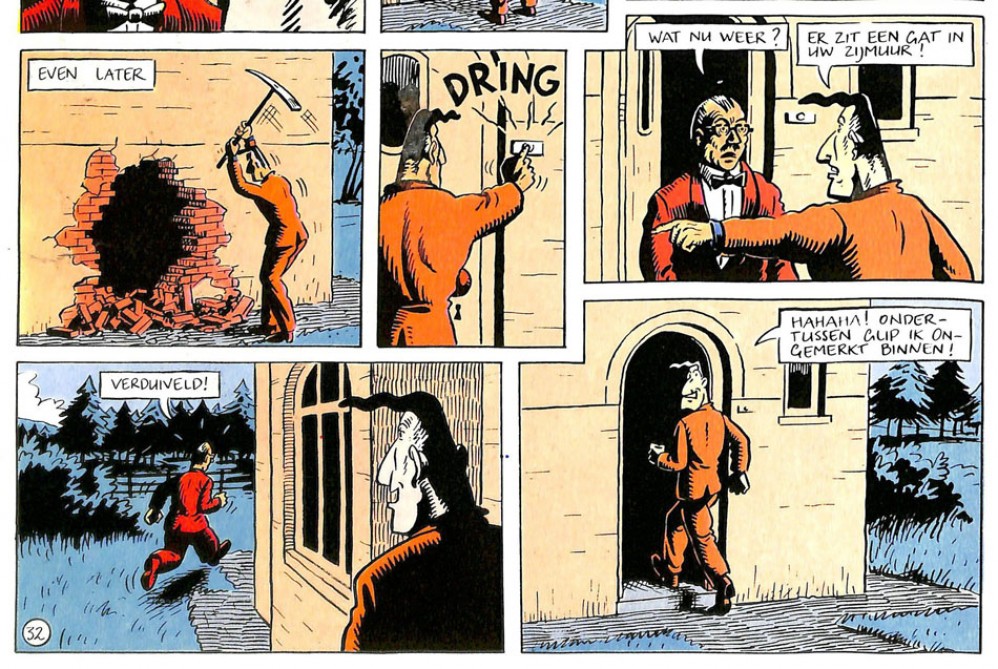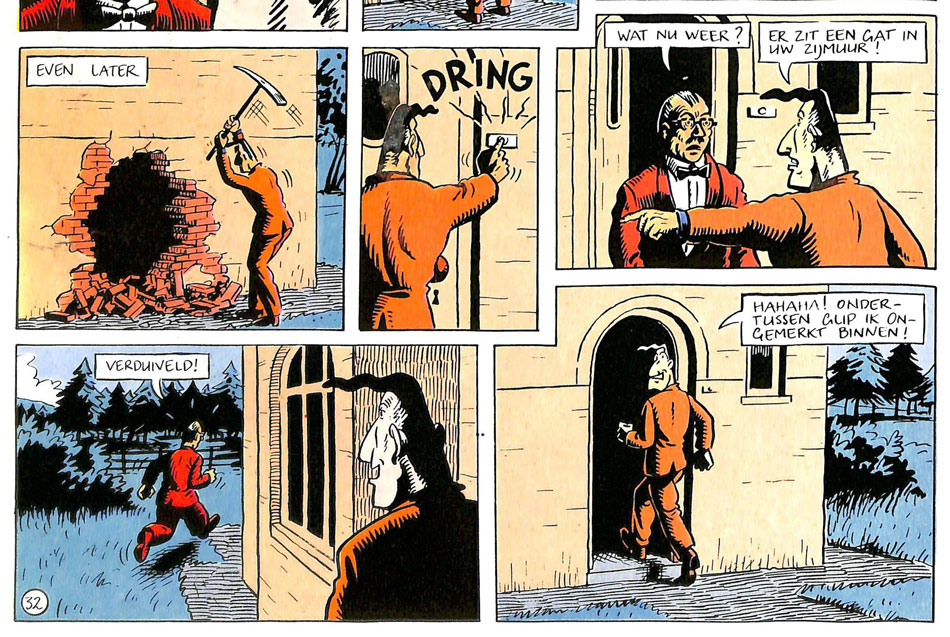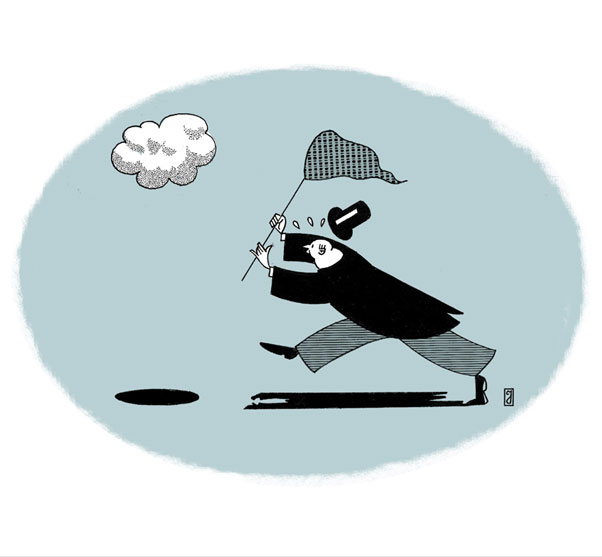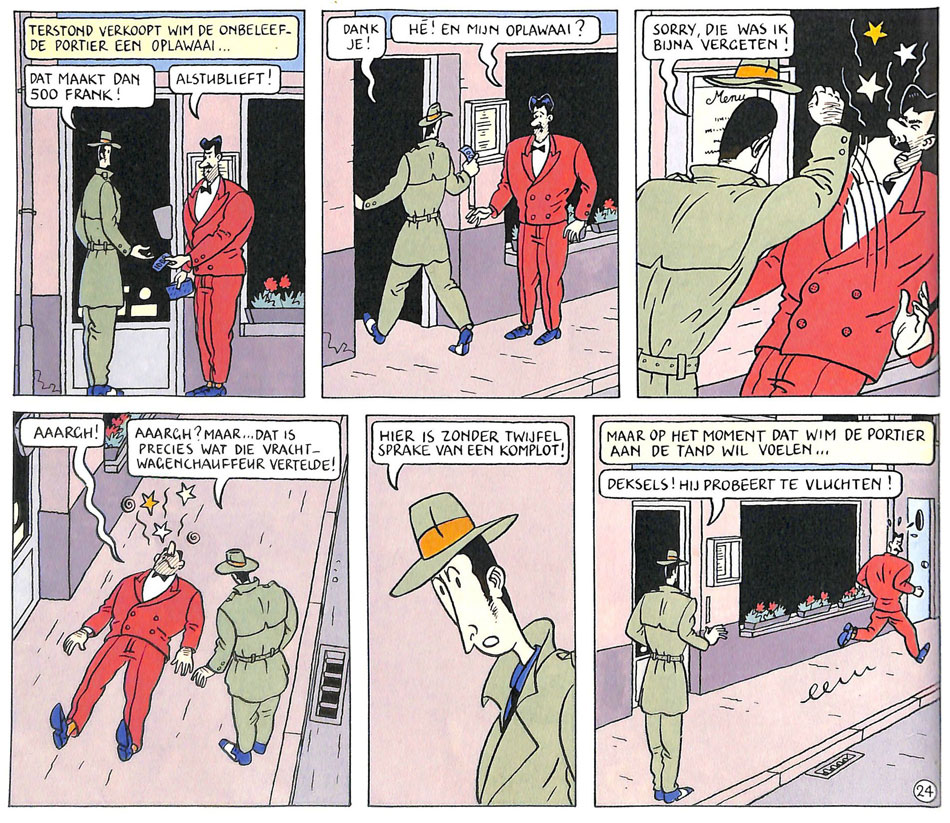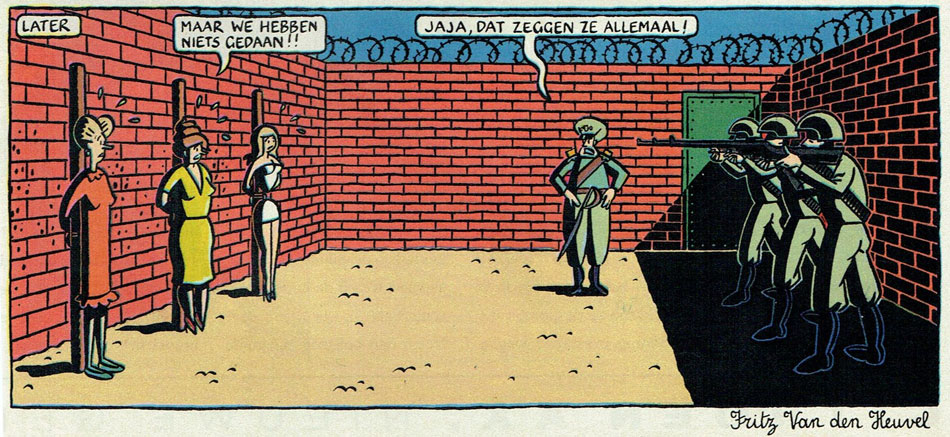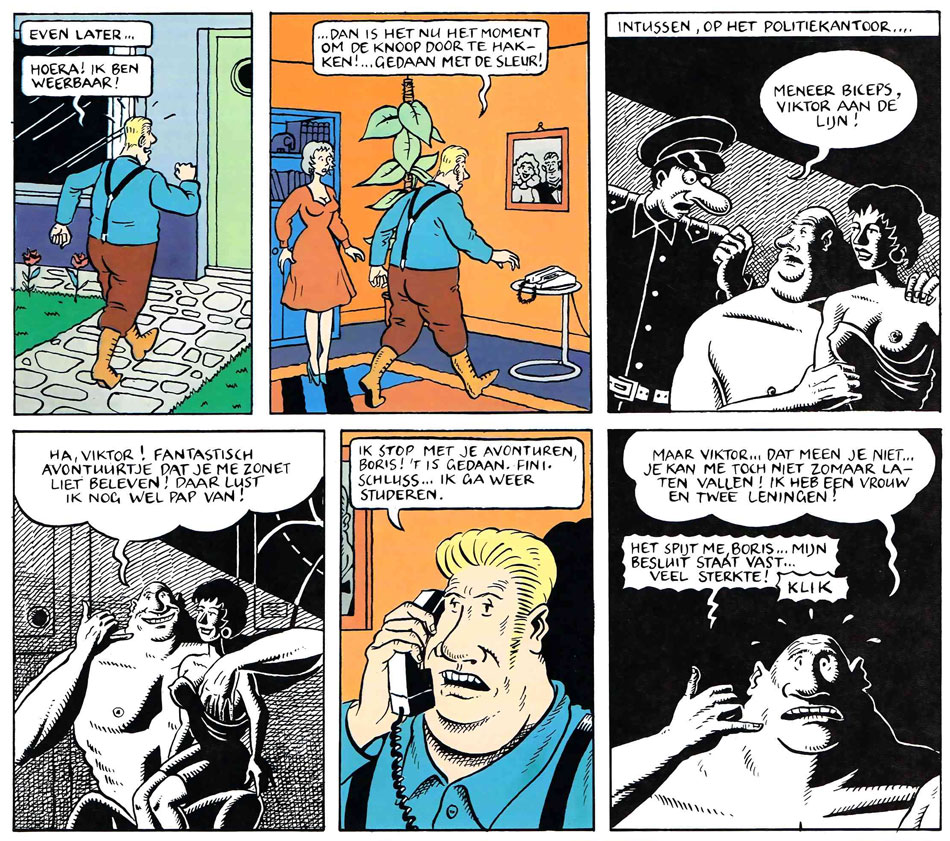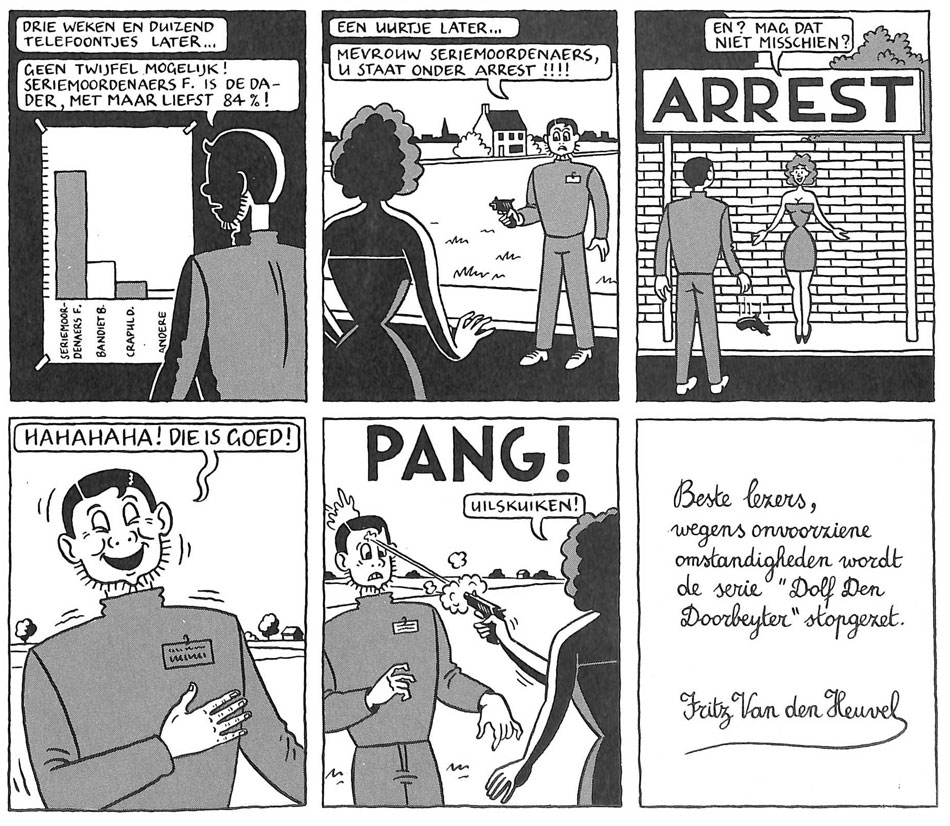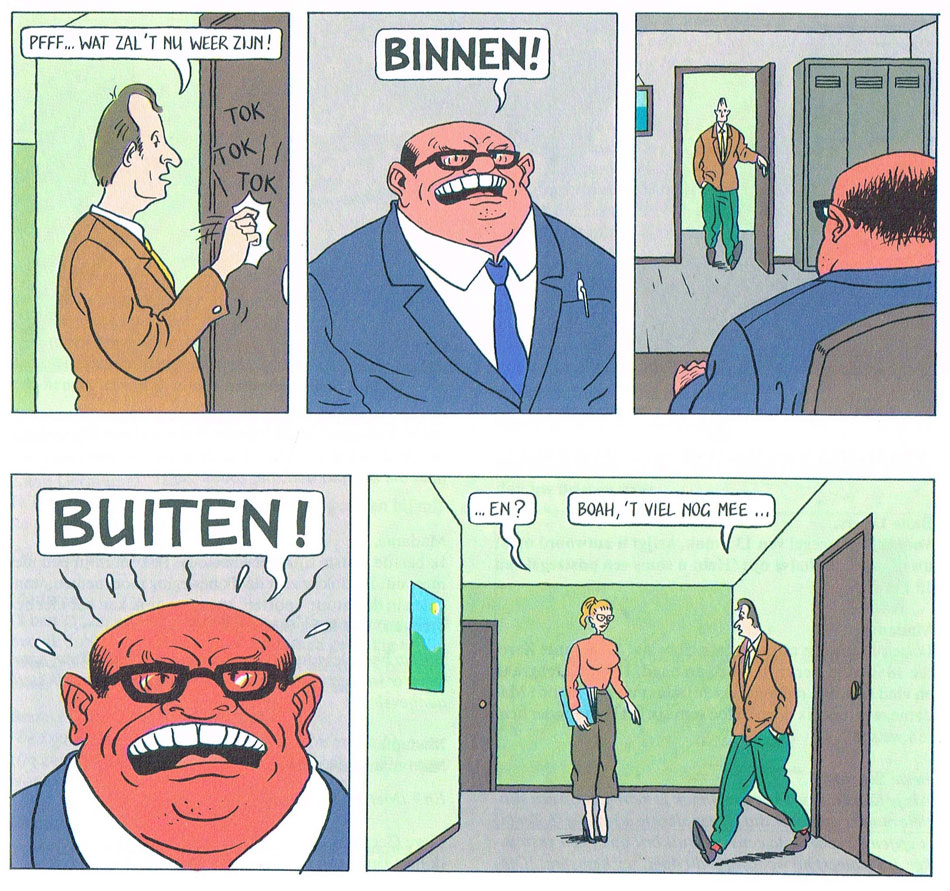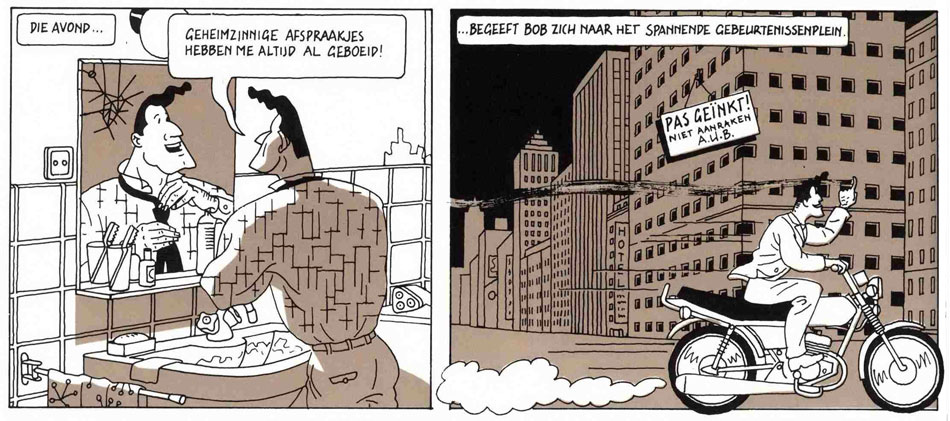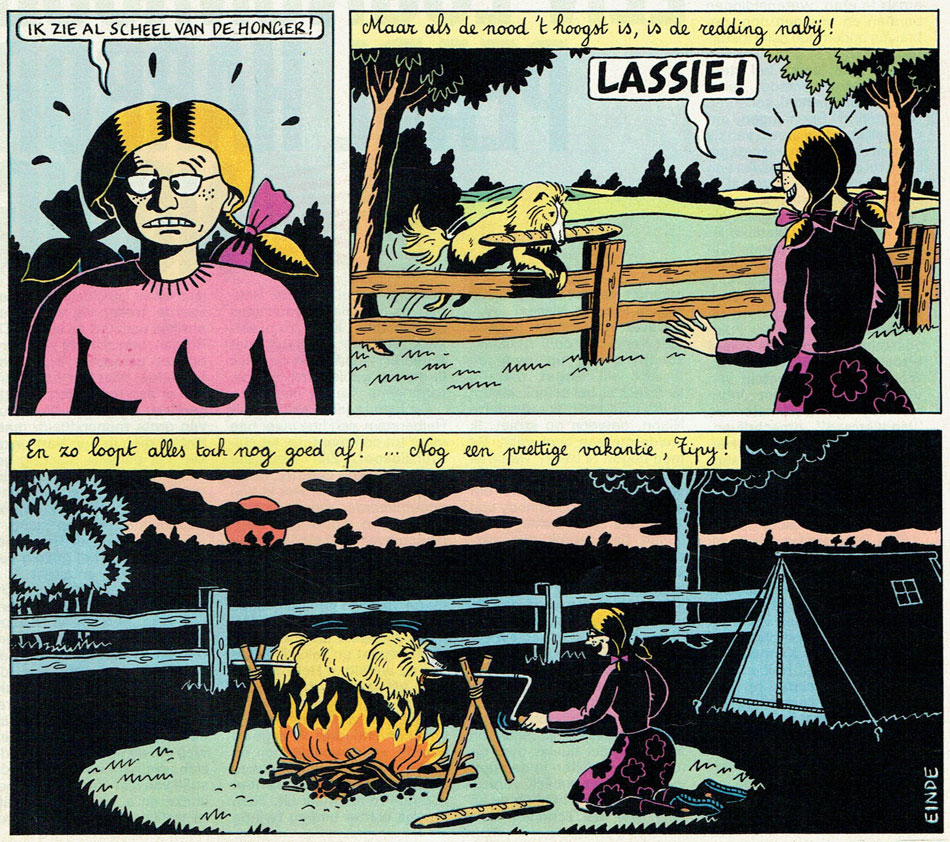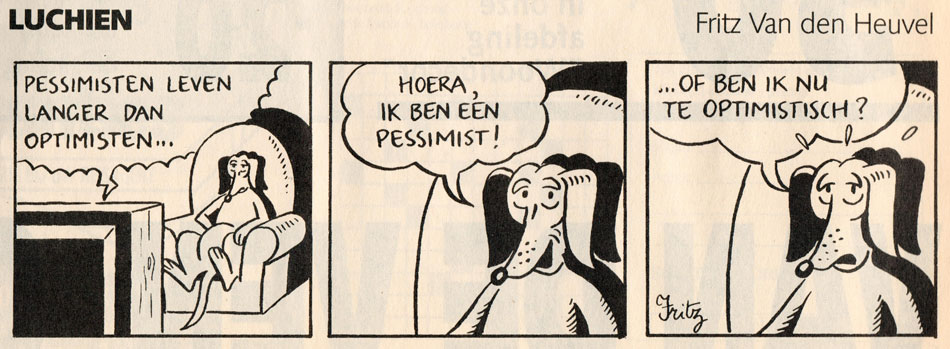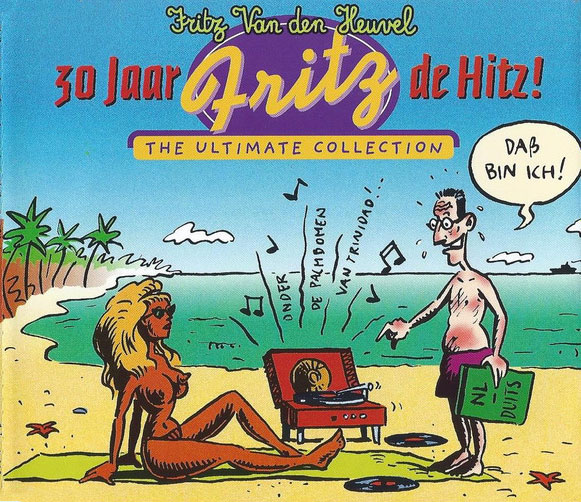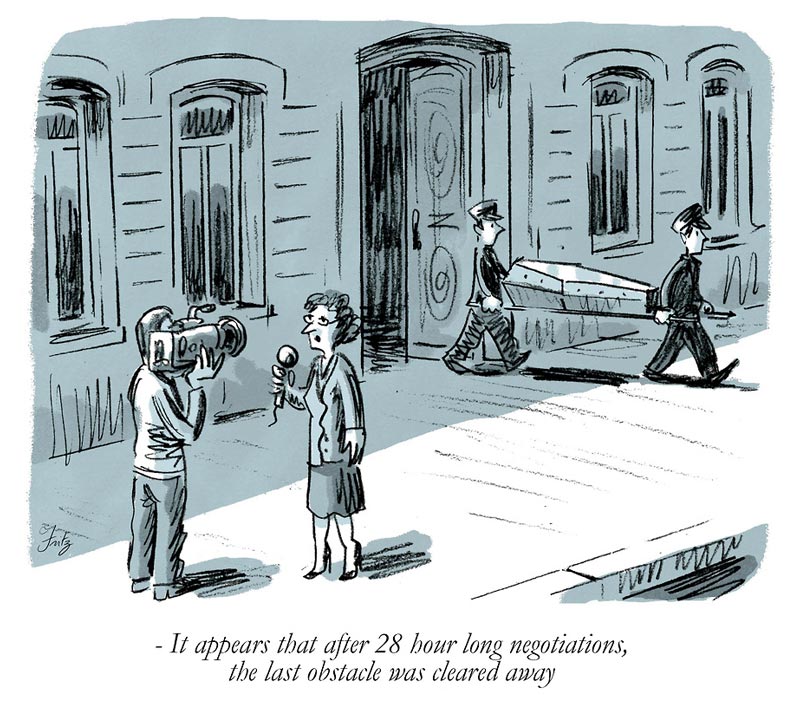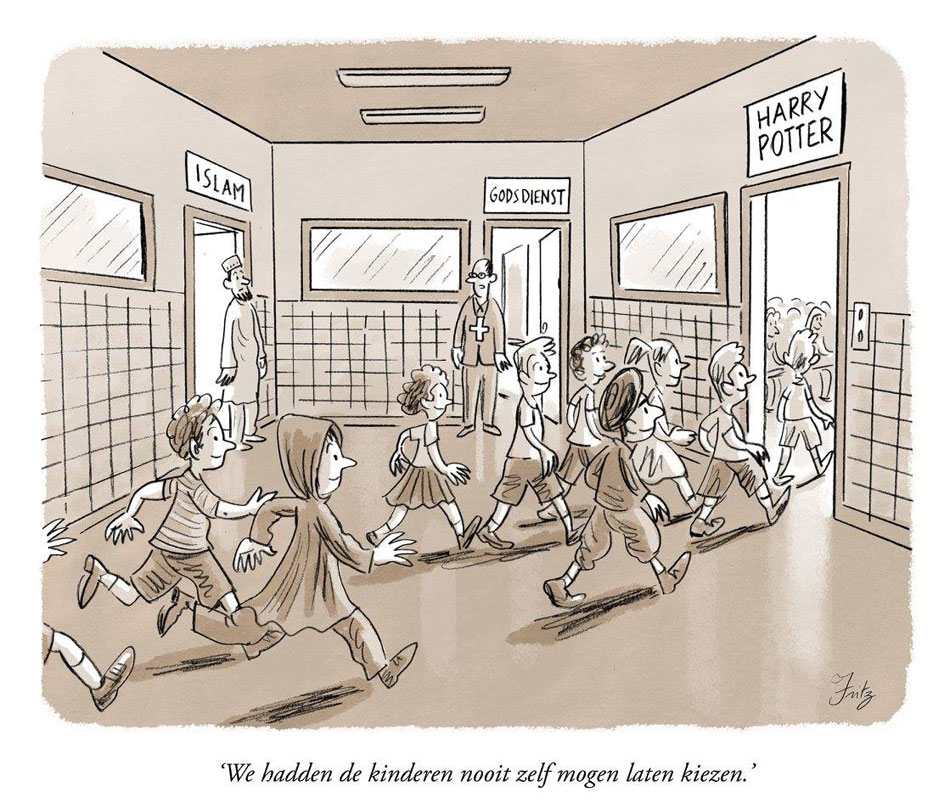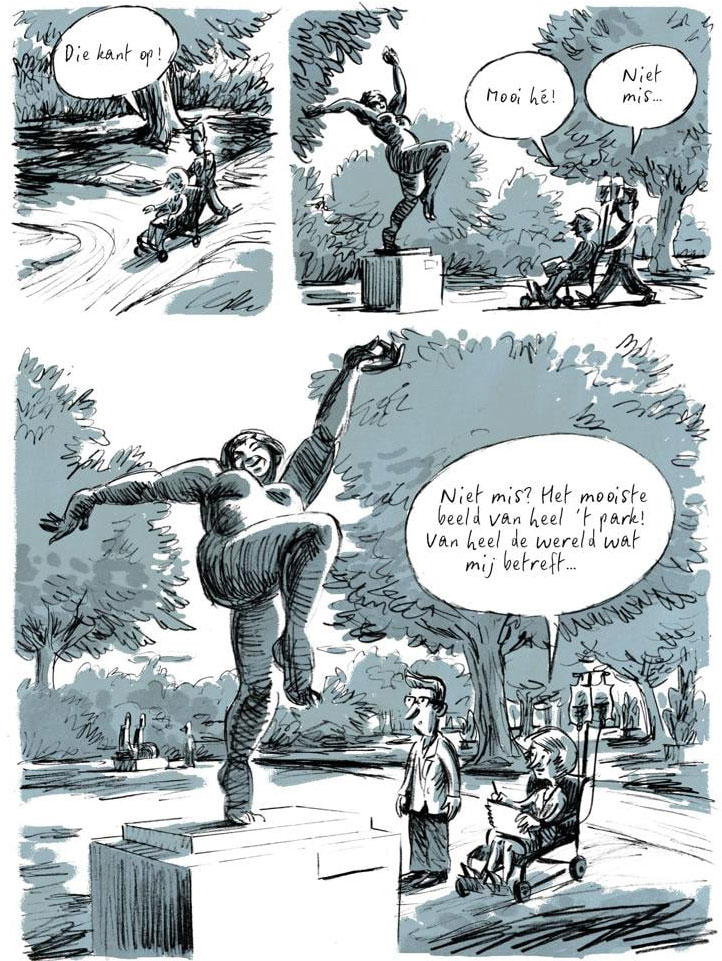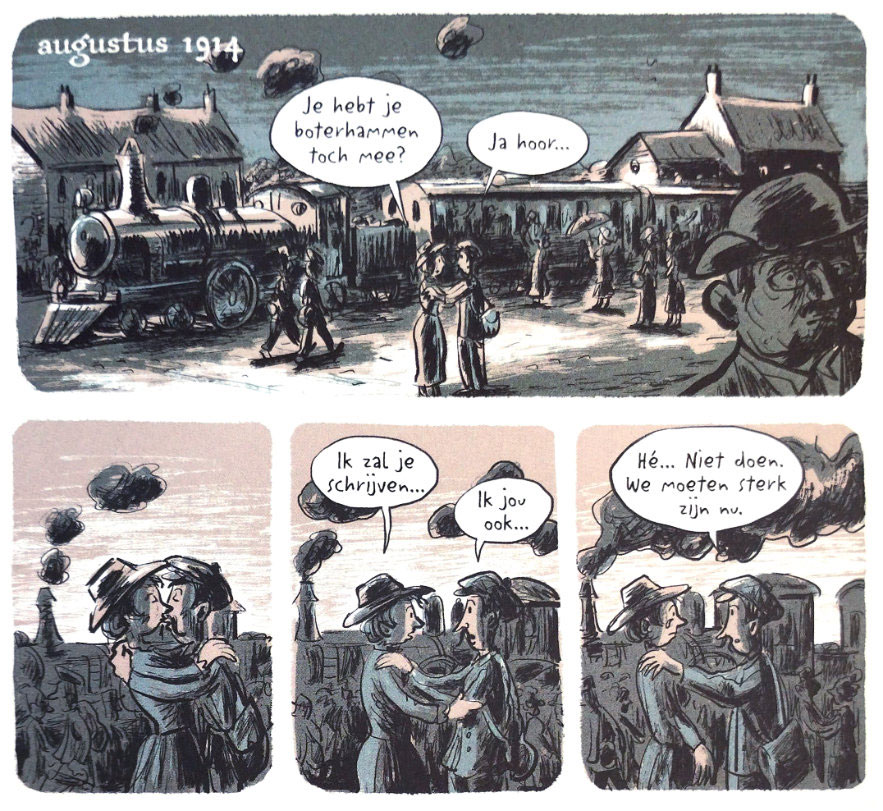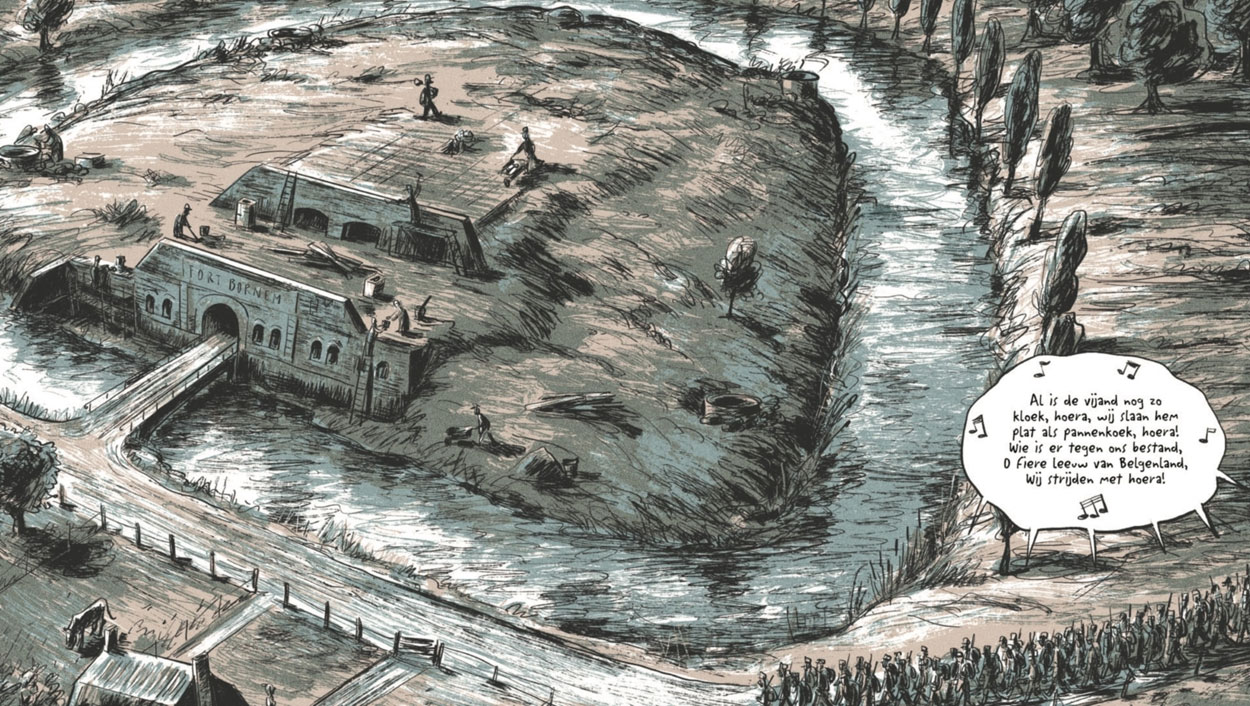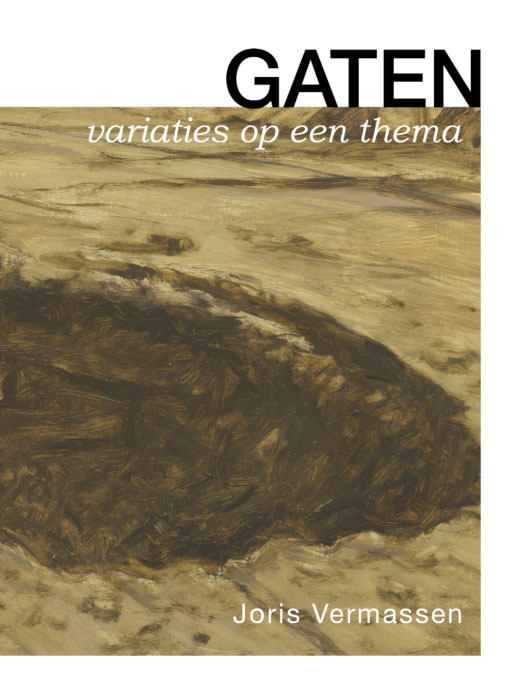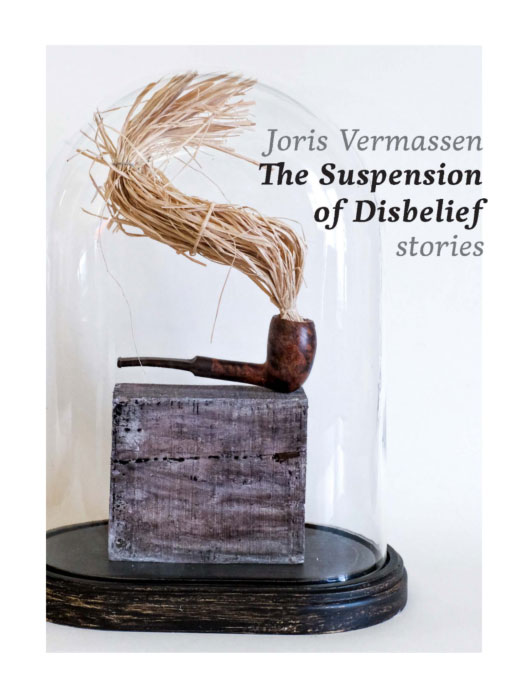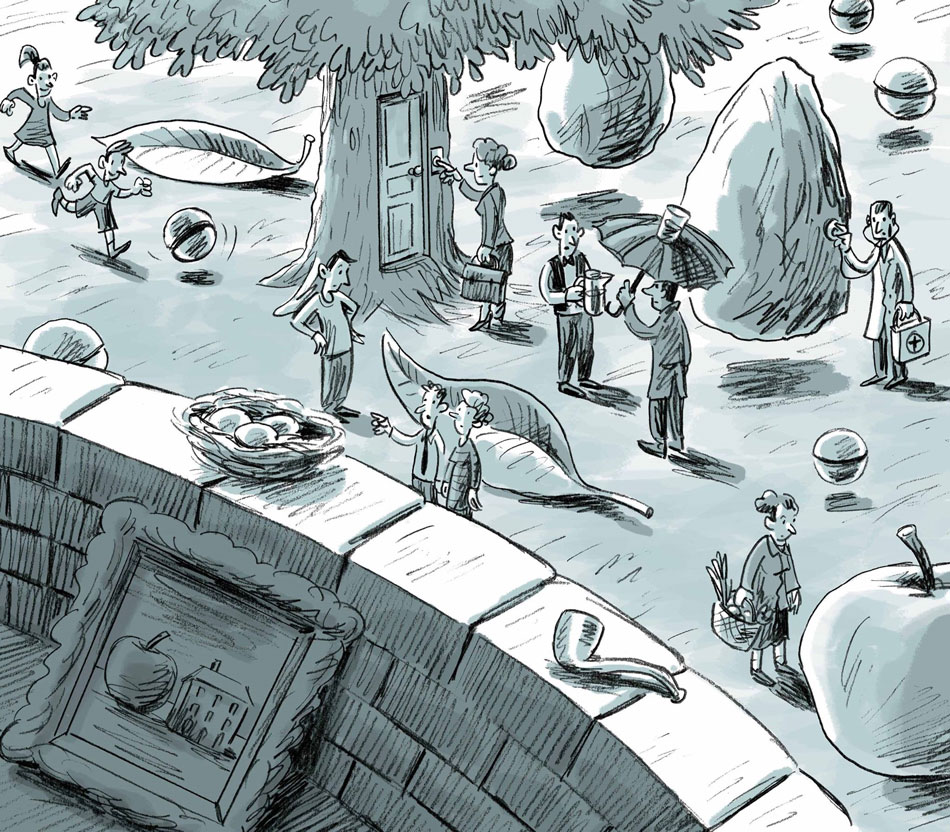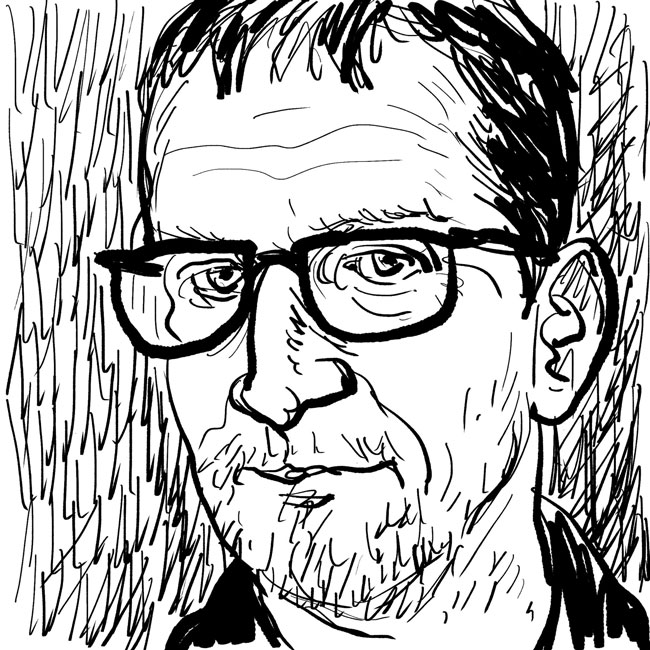'De Vermaledijde Daders' (1994). Bob De Kerpel carves a hole in the villain's wall to provide "a distraction" to "sneak inside."
Joris Vermassen, who also works under the pseudonym Fritz Van den Heuvel, is a multi-disciplinary Belgian artist, who has been active as a comic artist, editorial cartoonist, stand-up comedian, columnist, essayist, short story writer, radio writer and painter. Early in his career, he gained a cult following in the magazine Humo with absurd, metafictional gag comics and longer nonsensical adventure stories starring his quiffed simpleton Bob De Kerpel (1989-2001). Between 2013 and 2019, he was a one-panel editorial cartoonist for newspaper De Standaard. Later, Vermassen reinvented himself with more drama-filled, semi-autobiographical graphic novels. 'Het Zotte Geweld' (translated in English as 'Mad With Joy', 2014) centers on a comedian juggling between his cancer-stricken sister and his stage act. In 'Soldaat-Hovenier' (2025), Vermassen's grandfather's World War I diary forms the basis for a heartfelt human drama. Vermassen also scripted 'De Bamburgers' (2006-2012), a children's humor comic about a royal family, drawn by Simon Spruyt.
Early life and career
Joris Vermassen was born in 1964 in the city of Aalst. When he was still very young, he lost his father, which made the boy more insistent to follow his dreams before it was too late. From a young age, Vermassen enjoyed reading comics. As a child, he participated in a comic contest by electronics company Loewe Opta. The young contestants were asked to do something with Willy Vandersteen's comic characters Suske and Wiske, the lion mascot of Loewe Opta and a TV set. While most kids simply drew these characters watching television, Vermassen put Suske and Wiske on the moon with square-shaped helmets on, and gave the lion a television as a helmet. He won the ninth prize (a transistor radio) and learned an important life lesson: being original makes you stand out.
Vermassen received drawing lessons at the Academy of Aalst, followed by a course in Graphic Design at the Sint-Lukas School of Arts in Brussels, where he graduated in 1986. Among his fellow students were the future graphic artist Bärbel Van Den Akker and Geert De Sutter. As a student assignment, he created his first comic book, 'Het Geheim van de Zavel' (1983), published by St. Lucas. Since this early comic was made under time pressures, with cheap facilities and not much experience, he later regarded it as "awful".
Vermassen's favorite painters are Georges Braque and Egon Schiele, while his strongest influences from the world of comics have been Enki Bilal, Robert Crumb, Hergé, Kamagurka, Ever Meulen, Jean-Jacques Sempé and Art Spiegelman. Yet he never regarded himself as purely a comic artist, as he always wanted to explore other forms of creative expression. Hence his endeavors in stand-up comedy, editorial cartoons, fine arts, essays and short stories. His cartoonist colleague Erik Meynen once described Vermassen's work as "conceptual continuity" (a term lifted from rock musician Frank Zappa). In several interviews, Vermassen stated that he is sometimes more inspired by films than comics. Woody Allen in particular motivated him to make comedy with a beautiful balance between humor and drama, while the surrealness of Monty Python is another strong influence. As an avid jazz fan, he also enjoys improvising around a theme and, like Miles Davis, reinvent himself time and time again.
Illustration for Trends magazine (1987).
Bob De Kerpel and other absurd comics
Joris Vermassen's first officially published comic was a page in issue #2 of the French magazine Sortez La Chienne (1987). After graduation, Vermassen spent six months working at the publishing house Casterman, leading to comic publications in the magazines Wordt Vervolgd (issue #76, 1987) and Jouer Avec Quick et Flupke. He also appeared in the social-economic magazine Trends, but after a year, he was fired because the editor felt his drawings "lacked imagination". In an act of desperation, Vermassen took his work to Humo, where it was promptly accepted, bringing his comics to a wider audience from 1989 on. Vermassen was very grateful that Humo offered him a chance and a platform when other magazines didn't. Chief editor Guy Mortier even took the time to personally check his pages and sometimes give advice if he felt a joke could be improved. In appreciation, Mortier received a small guest role in the story 'Operatie Vrouwenhart'. Still, Vermassen felt his longer stories work better in album form, where the reader can follow the comedic flow better.
'Het Valse Kunstgebit' (1990).
In Humo, Vermassen started using the pseudonym Fritz Van den Heuvel, inspired by the name of Belgian artist and comic pioneer Frits Van den Berghe, in whose former house he lived at the time ("Heuvel" means hill in Dutch and "Berg" is mountain). His most recognizable character became the recurring anti-hero Bob De Kerpel, a big-chinned simpleton with a large black quiff. Since Humo also ran Kamagurka and Herr Seele's 'Cowboy Henk', some readers felt Bob and Henk had a very comparable design. However, interviewed by Toon Dohmen for ZozoLala magazine in 1993, Vermassen said that Seele originally didn't draw Henk with a big chin and only remodelled him after the 'Bob De Kerpel' stories started appearing. Presented as a "demolisher of TV sets", Bob starred in five stories: 'De Verdwenen Stembanden' (1989), 'Het Valse Kunstgebit' (1990), 'Operatie Vrouwenhart' (1991), 'De Vermaledijde Daders' (1994), 'De Rijzende Ster/'De Extravagante Exploten' (1997, 2001). Technically, Bob is present in only four-and-a-half, since 'De Vermaledijde Daders' starts off with a different protagonist, Lex Lenin, who originated in a previous two-page one-shot comic by Van den Heuvel: 'Lex Lenin Wordt Beroemd'. In 'De Vermaledijde Daders', Lenin investigates the notorious criminal Frans Daders until our hero falls off a cliff halfway through the story and dies. A Union of "Famous Comic Characters" holds a speedy conference to find a suitable replacement, but Lucky Luke and Asterix "are too busy with their own adventures", Superman "has a headache", Mickey Mouse "is too concerned with his branch in Paris", a Smurf needs to visit a speech therapist, while Tintin "only does commercials nowadays". In the end, De Kerpel is brought back to finish the story.
Panel from 'Drolkopje', a gag comic collected in 'De Kriminele Coverdief'.
Between 1989 and 1994, the publishers Dedalus and De Schaar collected the 'Bob De Kerpel' stories in four books. However, Vermassen wanted to avoid creating a series built around just one character, since these often turn into hollow factory products. As such, he drew one full-length story without De Kerpel, 'Het Laatste Einde' (1993, with assistance by an artist going by the name of Matto D. Sputnik). Fuelled by his doubts about a future as a comic creator, 'Het Laatste Einde' ("The Final End") happens to be Vermassen's most metafictional and personal comic strip. The plot centers on the troubled relationship between fictional comic creator Viktor Plank and his superhero character Boris Biceps (presented as a comic-within-a-comic). Plank always wanted to be a gynaecologist, but his father felt this was a "cunt profession" and forced him to become a cartoonist instead. The disgruntled comic artist not only hates his job, but is also jealous of Boris, who receives all the glory and success. It motivates him to quit the series, but he's dragged back into it due to audience and publisher's demands.
In real life, Vermassen also brought back De Kerpel in his next stories. But while 'De Rijzende Ster' was serialized in Humo between 30 September and 18 November 1997, the story was discontinued before it was finished. The comic's cancellation was a culmination of events. While Vermassen didn't feel at home in Humo and had already mentally distanced himself from the magazine in 1994, he returned to its pages out of desperation. In the year 1997, the artist's sister died, and on top of that plans for a television series and interactive webcomic fell through. His return to Humo didn't bring the solace Vermassen hoped for, and he left the magazine for good. As he stated in an e-mail to Lambiek: "Lesson learned: never go back to what you leave behind". After disappearing from Humo, the exploits of Bob De Kerpel appeared in Exploot, the magazine of Ghent University College, where Vermassen was a teacher at the Royal Academy of Fine Arts. In 2001, the University released the final Bob book, 'De Extravagante Exploten van Bob de Kerpel' (2001), which contained an amended and finished version of 'De Rijzende Ster', as well as cartoons published in Exploot. Vermassen took the opportunity to deliberately kill off De Kerpel in the story, to start a new chapter in his life.
'Dolf den Doorbeyter'. The "serial killer" is "under arrest", but she asks: "So? Is that not permitted?".
In 1992, in between two longer adventure stories, Vermassen created several one-to-two page gag comics for Humo. Since they were easier to make, they offered a welcome intermission while preparing longer adventures again, simultaneously keeping his cult followers tied in. The short gags are pastiches of typical classic adventure comics, featuring ludicrous one-shot characters, like 'Drolkopje' ("Little Turdhead") or 'Flup, De Eeuwige Te Laat Komer' ("Flup, The Eternal Latecomer"). In 'Dolf Den Doorbeyter', Dolf notices many newspaper comic series are abruptly discontinued and deduces it's the work of a "serial killer". He eventually tracks down the culprit, but is then murdered himself, ending his series just as suddenly. These gags were collected in the album 'De Kriminele Coverdief' (De Schaar, 1992). In addition, the cartoonist Kamagurka also scripted a few short gags for Van den Heuvel, which were printed in the comic book 'Lava TV Presenteert' (1990), based on Kamagurka and Herr Seele's sketch TV show 'Lava'.
Both in his short and longer stories, Vermassen offers a fine balance between witty wordplay, self-reflexive comedy and enjoyable nonsense. In 'De Verdwenen Stembanden', a detective shoots down a runaway leg. When a doctor is brought in, he advises amputation. Yet on the operation table, the leg suddenly shows "rejection symptoms" and disappears to the "eternal football fields". In 'Operatie Vrouwenhart', a woman gets pregnant with literal "flowers in her tummy". Her father is furious that she's "in love without even being married", until his wife calms him down by reminding him that they too experienced the same situation. In one of the most ludicrous plotlines in Vermassen's work, readers of 'De Vermaledijde Daders' (1994) learn about the "notorious gangster" Frans Daders, who started out as a literal "kruimeldief" ("a petty thief"), stealing bread crumbs. He is sentenced to "an hour of jail time", but is released after only half an hour "on good behavior." More ambitious, Daders decides to steal "a whole bread", but enters a butcher's shop by mistake. Undaunted, he then forces the butcher to re-educate himself for years to become a baker, just to be able to steal a loaf of bread from him. Even on the back cover of each album, where "recent appearances" are announced, Vermassen included a picture of the Virgin Mary. The artist later reflected: "For me, those word-picture jokes were a step in a long process of exploring the relationship between image and language, which later culminated in a PhD." The author also enjoyed toying around with the clichés and tropes of the comic strip medium. In 'Operatie Vrouwenhart', for instance, the very script of the story De Kerpel appears in is stolen. He spends most of the plot trying to retrieve it.
'De Verdwenen Stembanden' (1989).
Despite all the zaniness, the Fritz Van den Heuvel comics are well-structured. Each gag is built on top of more madness to brilliant punchlines. In the previously mentioned ZozoLala interview, the artist expressed his irritation with gag comics that only have one joke at the end of a page, which he described as "milking". In his humor comics, almost every panel has a great gag and still it never feels overstuffed or forced. All the illogicalness in his absurd stories has a logical build-up. Vermassen's artwork shows obvious influence from Hergé's "Clear Line", but some of his later stories feature more heavy shading and looser lines. In his opinion, drawings and stories should be equally strong. He dislikes beautifully drawn comics that have nothing to say, but also imaginative comics with minimalistic art too sloppy to read properly.
'Tipy Gaat Kamperen', a parody of Marcel Marlier's 'Tiny' book series, with a guest role for Lassie.
Luchien
Between 3 October and 26 December 1993, TV host Mark Uytterhoeven presented the humorous talk show 'Morgen Maandag' ("Tomorrow Monday"), broadcast live on Sunday evenings. As part of its promotion, a special Monday newspaper was made with the title 'Gisteren Zondag' ("Yesterday Sunday"). Each issue documented what had happened in last night's episode, complete with photos and additional background info. Understandably, most of its content had to be prepared during and directly after the broadcast, to rush it to stores the next morning. One exception was the only comic in its pages, Fritz Van den Heuvel's 'Luchien'. Each gag centered on an apathetic anthropomorphic dog, obsessed with watching TV. He either comments on what he sees on the screen, or on his own viewing behavior. The 'Luchien' strip was also notable for never referencing 'Morgen Maandag' or Uytterhoeven at all, presumably since Van den Heuvel had prepared his gags long beforehand and hadn't been informed what the unpredictable TV show would be about. 'Luchien' ran until the final episode of 'Morgen Maandag' was broadcast.
Luchien (Gisteren Zondag #4, 24 October 1993). Translation: "Pessimists live longer than optimists..." - "Hooray, I'm a pessimist! Or am I being too optimistic now?".
Other comics
In 2001, Van den Heuvel made a gag comic for the men's magazine Menzo, titled 'Fritz', about a loser who can't deal with women. While it was popular with the magazine's female editors, it was less well-received by its male readership and cancelled. Other comics and cartoons by his hand have appeared in Focus Knack, the cultural supplement of the weekly Knack, the Dutch alternative comic magazine Zone 5300 and the Dutch opinion magazine De Groene Amsterdammer.
In the 1990s, Van den Heuvel scripted a comic intended for the comic weekly Suske en Wiske Weekblad, drawn by his college friend Geert De Sutter. There, it remained shelved, but in 2008 the three-page story 'Bagues en Smoul' (a parody of 'Blake & Mortimer' by E.P. Jacobs) was eventually published in issue #5 of P@per, the comic supplement of Brabant Strip Magazine. For the artist Simon Spruyt, Vermassen wrote three volumes of 'De Bamburgers' (2006-2012), a children's humor comic about the royal dynasty of Nordanië, a fictional island between the United Kingdom and the European mainland. Its monarchy consists of king Ludwig and queen Divina, and their two children, the bored princes Leo and Louis. After serialization in MYX magazine, the book compilations were published by Silvester.
Comedy career
In 1989-1990, Joris Vermassen collaborated behind the scenes of Kamagurka and Herr Seele's TV sketch show 'Lava' and in 1993 of Mark Uytterhoeven's humorous talk show 'Morgen Maandag'. He also wrote material for the satirical radio shows 'Het Vrije Westen' (1995-1997), 'De Nieuwe Wereld' (1998-2004), 'De Rechtvaardige Rechters' (2000) and 'Het Reyers Complex' (with comedian Bert Kruismans, 2004-2006), all broadcast on Radio 1. His contributions to 'De Nieuwe Wereld', often in collaboration with musician Ronny Mosuse (of The Radios fame), were usually broadcast on Wednesdays. Vermassen said he prefers radio over TV, because there's more respect for its scriptwriters. One time, he had written a song mocking singer Céline Dion, which was to be sung by a well-known Flemish singer. When she refused, a replacement was brought in. Vermassen: "On TV, they would have simply censored my lyrics."
'30 Jaar Fritz De Hitz!' (1995).
Between 1992 and 2007, Vermassen also performed as a stand-up comedian. Originally, he suffered from stage fright, but gained more confidence when he won the 1994 Humorologie award. Interviewed by Liv Laveyne (De Morgen, 23 November 2002), he explained: "I love comedy that exposes the soul. It's more difficult than comedy based on current events: while the comedian is joking on stage about royalty and ministers, people are sitting safely in the hall. They laugh because the slaughtered holy cows aren't theirs. Everything is autobiographical, even if it's pure fiction, which works very confrontational." Vermassen pointed out that he is a socially conscious artist who "wants to cross the border of gratuitous comedy. I don't like joke book comedy. I prefer sensitive comedy with pins. It's not just about making audiences laugh, you also need a story to tell. Not just in comedy, but also in the art world. The plastic arts are full of bullshit (…) People have no sense of judgement. Experts give their opinion, the media jumps on the bandwagon. (…) Why can one thing please me and the other not? It's a thin line, just like with comedy: the difference between being funny and making a fool out of yourself is very small."
Vermassen toured Flanders with stand-up shows like 'Fritz the Hitz' and 'De Chaostheorie'. In 1995, a maxisingle, '30 Jaar Fritz De Hitz! - The Ultimate Collection' was released, featuring four humorous songs, followed in 2007 by a CD compilation of his stand-up act, 'Hits en Bits (Standup & Songs)'. Eventually, Vermassen decided to quit stand-up, because people expected him to create eruptions of laughter every 30 seconds, which he felt became tiresome and creatively unsatisfying.
Cartoon by Fritz Van den Heuvel.
Cartoons
From 2013 until 2019, Joris Vermassen's editorial cartoons ran in DS Avond, the evening edition of the newspaper De Standaard, under the pseudonym "Dr. Fritz". Using a one-panel format, he commented on current events or visualized more straightforward absurd situations. Interviewed by Sam De Wilde (Stripgids, 7 July 2025), Vermassen credited his editorial cartoons with forcing him to work faster, more efficiently and create more striking imagery, which proved beneficial for his later work. One compilation book was released: 'Saaie Boel Hier' (Vrijdag, 2015). Although his cartoons offered him financial stability, Vermassen eventually ended them, because the daily deadlines made it impossible for him to focus on other projects.
The religion teacher complains: "We should have never let the children choose for themselves." (De Standaard, 6 May 2016).
Het Zotte Geweld
In 2013, Vermassen released his first "serious" graphic novel, 'Het Zotte Geweld' (Vrijdag, 2013), a tragicomical, semi-autobiographical story about stand-up comedian Tom Steurs, who suffers a mid-life crisis. His relationship goes downhill, while his stand-up act never truly gets off the ground. His manager advises him to make his humor more mainstream, which he refuses. Meanwhile Steurs also copes with his wheelchair-bound sister Elke, who is succumbing to cancer in a hospital. The title refers to the real-life statue 'Het Zotte Geweld' ("The Mad Violence") by Rik Wouters in the Antwerp City Park, where Steurs often takes Elke for some distraction.
The story was inspired by Vermassen's real-life sister, who died from pancreatic cancer at an early age. While he was moved by her unfortunate passing and many events in 'Het Zotte Geweld' are inspired by personal memories and emotions, not everything is a direct reflection. Vermassen wanted to avoid putting himself in the forefront. To keep some emotional distance, he used a fictional protagonist to serve as an alter ego. Interviewed in VPRO Gids issue #47 of November 2014, he said: "I saw a good story in the fact that somebody performs on stage during evenings to make people laugh and the next morning has to say goodbye to somebody who's dying. That heavy emotion and conflict in the character was my starting point." He also shied away from Hollywood-esque clichés, like having Elke pass away on her deathbed, surrounded by her loved ones. "In real life people die when you aren't around. As I was drawing the story, I noticed that this would be the overall theme. Tom constantly thinks he doesn't spend enough time with his sister and doesn't do enough for her."
'Het Zotte Geweld' (2013), featuring the real-life statue 'Het Zotte Geweld' by Rik Wouters.
Originally, Vermassen envisioned 'Het Zotte Geweld' as a film, but in the end it was easier and less expensive to turn it into a comic book instead. He did take several precautions. Many dialogues had to be shortened to fit into word balloons. Several scenes had to be recut, as dictated by the lay-out. He made the characters nuanced personalities to avoid comparisons to one-dimensional, cardboard comic book characters. His first draft was a bright, fully worked out, multi-color version, but his test readers felt this didn't fit the tone of his story. As a result, he redrew everything in a more sketchy style, with only one supporting grey color and more emphasis on light, shading and atmosphere. Last but not least, he published it under his real name, so his fans wouldn't expect an absurd humor comic.
'Het Zotte Geweld' was an unexpected success, instantly selling out. It received rave reviews, awards and was released both in The Netherlands and in an English-language version, 'Mad With Joy'. In 2025, the original, multi-color version of 'Het Zotte Geweld' was released too.
'Soldaat-Hovenier: Een Liefde Tussen Hemel en Hel' (2025).
Soldaat-Hovenier
For his next graphic novel, 'Soldaat-Hovenier: Een Liefde Tussen Hemel en Hel' (Borgerhoff & Lamberigts, 2025), Vermassen took inspiration from his grandfather, Alois Vermassen (1882-1974), who was a reservist in the Belgian army during the First World War. In 1915, he survived a grenade attack in the Veurnestraat in Poperinge. During his military service, he kept a diary, which his grandson first read when he was 20. Back then, Vermassen felt the handwriting was difficult to decipher. But when he re-read it in 2010, he felt it contained an interesting narrative, and spent more than a decade on a graphic novel adaptation. His original deadline was the 100th anniversary of the First World War in 2014, but many other projects interfered. In hindsight, Vermassen was glad that he didn't rush things out, but kept revising the narrative and its lay-out. A major setback was his diagnosis with arthrosis in 2020, but he solved it by switching to digital drawing.
In preparation of his book, Vermassen visited all the locations in Flanders and France where his grandfather had been during and after the war. He also did a lot of historical research and let a military history expert read his draft. Certain anecdotes and quotes were lifted directly from Vermassen's grandfather's diary, including the characters of Alois himself, his fiancé Clothilde (Vermassen's grandmother) and his good friend Raymond. But Vermassen did alter certain elements as a form or artistic liberty. In his story, Aloïs is a devout Catholic who wants to wait having sex until marriage. Although Clothilde is his fiancé, he falls in love with Marie, the maid of painter Claude Monet, which brings him into conflict with his religious convictions. Marie is a purely fictional character and Vermassen has no proof that his grandfather ever met Monet. Yet, when his grandfather was stationed in the French town of Port-Villez, another soldier wanted to marry a local girl, but didn't receive her father's permission. Instead, the father felt Alois was a far better match for his daughter. Although he refused his offer, they remained good friends in written correspondence, years after the war. To Vermassen, this proved that "history could have taken a whole different turn." When Monet lived in Port-Villez, a soldier once worked in his house. Since his grandfather also spent some time in Port-Villez, Vermassen again took the liberty of bringing the two together. The real Raymond also disappeared from Alois' life after being sent to a different regiment. For dramatic purposes, Vermassen let Raymond get wounded in battle, leading to a new reunion. Contrary to what Vermassen implies in his book, he only had access to two of Clothilde's letters. He therefore took inspiration from poet and novelist Virginie Loveling's diaries, which were written around the same period.
'Soldaat-Hovenier: Een Liefde Tussen Hemel en Hel' (2025).
But in Vermassen's opinion, it doesn't really matter how many elements in a story happened in real life or not, as long as it's a strongly-told plot. In the same way, he didn't want to make the First World War the complete focus. After all the commemorations of the Great War in 2014-2018, he felt that audiences would be tired of "yet another bunch of scenes set in the trenches", so 'Soldaat-Hovenier' is a more general human drama about unrequited love, regret and the feeling of being out of control in a chaotic world. When the COVID-19 pandemic (2020-2022) forced most of the world into lockdown, Vermassen not only had more time to work on his comic without distractions, but also could empathize more with Alois, who was struck with influenza during the pandemic of 1918-1920.
'Soldaat-Hovenier' received praise from painter Michaël Borremans, columnist Noël Slangen and comic artist Barbara Stok. It was also adapted into a stage show, in which Vermassen read passages from his grandfather's diary, while imagery from his graphic novel was projected against musical orchestration by Yves Bondue.
'Gaten' and 'The Suspension of Disbelief'.
Literary and artistic career
Between 2013 and 2016, Vermassen wrote columns for the modern art magazine (H)Art (nowadays Glean). He quit when he achieved a doctorate in fine arts and wanted to create art of his own, feeling it would be hypocritical to remain a judge of other people's artistic endeavors. He curated and participated in several group exhibitions, like 'Poppositions' (2013), 'Land of Garage', 'Wild Grid' (2015), 'Buiten Boord' (2016) and 'No Comment' (2017). For the 2023 Art Festival Watou, held between 1 July and 3 September of that year, Vermassen painted and drew craters left behind by the impact of bomb explosions, both in historical wars, like World War I, and in contemporary military conflicts, like the Russian-Ukrainian War. These distant, impersonal depictions of ruptured earth are juxtaposed with short stories by Vermassen about the human lives disfigured or lost in these bombings. The drawings were later collected in the book 'Gaten: Variaties Op Een Thema' (Skribis, 2023). A case of "conceptual continuity", the 2023 Watou art project was largely inspired by his grandfather's diary, a source he explored again in his 2025 graphic novel 'Soldaat-Hovenier'.
Between 23 June and 7 July 2019, Vermassen had his first solo exhibition, 'Bloed, Een Beeldverhaal', held in art gallery D'Apostrof in Deinze. He made a series of paintings, texts, drawings, photos, video and sound recordings illustrating his short story 'Bloed', about a refugee who visits a small village, where he meets a local artist. The title not only refers to bloodshed during World War II and current wars that motivate refugees to flee their country of origin, but also the Holy Blood Procession event in Meigem, a sub-municipality of Deinze. The expo came with a companion book, 'Bloed'.
During the COVID-19 pandemic (2020-2022), when lockdowns were in full effect, Vermassen thought of the demographic most at risk and subject of alienation, seniors in rest homes. Every week, he made three to four iPad drawings of the residents of home Meredal in Mere, where his sister was working as physiotherapist and where his mother was taken care of. His initiative received praise and media attention.
Portrait for 'The Suspension of Disbelief'.
Between 3 October and 19 November 2021, Vermassen curated 'The Suspension of Disbelief' in the Center of Fine Arts in the Dutch coastal province of Zeeland. Originally scheduled for 2020, it had to be postponed because of the COVID-19 pandemic. Vermassen felt an audience's willingness to set their scepticism aside when reading, listening or watching a work of fiction is an interesting phenomenon. He was directly inspired by the inhabitants of Zeeland, a province known for its seaside tourism and very traditional, devout Christians. Vermassen was intrigued by the sharp contrast between this religious devotion and the hedonism of the tourists. He wrote several short stories about "suspension of disbelief", some set in Zeeland and made in direct collaboration with the local Zeelandians Hans de Ridder, Mohamad Abo Zarraa and Suzan van Sighem. The expo featured Vermassen's paintings, sculptures and illustrations, while his short stories were collected in a companion book, 'Suspension of Disbelief'. On the same trail, he released another book, 'Heilige Tekst, Goddeloos Beeld' (2018), a non-fiction work about the trials and tribulations between image, politics and religion. In the book, Vermassen discussed how in past and present imagery has caused controversy among easily offended politicians and religious leaders, with the then-recent example of the 2015 terrorist attacks on Charlie Hebdo's office. He also discussed the interpretations we give to imagery and how it can be both powerful and deceiving.
Apple Store in Brussels, 2015, referencing both the brand 'Apple' and the work of Brussels surrealist painter René Magritte.
Graphic contributions
In 1990, Vermassen drew a comic strip for the Christian Mutuality, to educate young people in search of a job. He was one of many Belgian cartoonists to make special cartoons and comics for Gilles Dal's book 'België, Et Cetera' (Van Halewyck, 2016), a funny look at the history of Belgium. In 2020, Vermassen also drew portraits of iconic jazz musicians for Geert Declercq and Filip Verneert's book 'De Jazzboom' (2008).
Recognition
In 1994, Joris Vermassen won the Humorologie contest. In September 2006, his and Simon Spruyt's 'De Bamburgers' received the Stripschapspenning for "Best Dutch-Language Youth Comic". In 2015, 'Het Zotte Geweld' received the Cutting Edge Award for "Best Dutch-language Comic". In 2016, Vermassen achieved a doctorate arts at the University of Ghent. Joris Vermassen has been named an influence on Katrien Van Schuylenbergh.
Other activities
Vermassen was a member of the collective and website The Cartoonist, established by Marec, where Belgian cartoonists make their archived and new work available to the public. In 2015, Vermassen and Willy Linthout were jury members during the election of De Plastieken Plunk award. He also hosts his own blog and works as an assistant-professor at the Academy of Fine Arts in Ghent.
Self-portrait.


